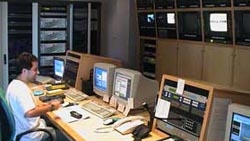Automation Technology at IBC

vsn system at TV Castilla Y León in Valladolid, Spain.
At IBC2005, Automation Technology Update had the opportunity the talk to Pedro Serrano, sales director of JustEdit, developers of the vsn solutions for playout, digital newsroom and archive automation.
Automation Technology Update: What is single most important reason that a broadcaster should use automation?
Pedro Serrano: Of course economic reasons, to increase production and/or reduce costs.
ATU: What areas should a broadcaster automate first?
PS: It all depends on which channel we’re talking about and its specific programming and operation. For an average broadcaster, a general rule could be: on-air playout (including commercials), ingest, then newsroom, archive and digital asset management and finally facility management. As long as they select open systems, the process should be smooth and run at its own pace to get the desired result, without compromising daily operations.
ATU: So, does this mean the broadcaster can approach automation with a “building-block” approach? If so, doesn’t this mean that the broadcast is then forever locked into one vendor?
PS: Yes, the “building blocks” approach can be achieved today, through the appropriate consultancy and design. Again if the selected solutions are open and ‘standards compliant’ the channel will not be locked into a single vendor at all. We already have several examples of this.
ATU: What are some of the regional differences in how automation is implemented?
PS: From our experience, we have found that automation deployment works in the same way as past technological advance in the broadcasting world; in each country there are waves ridden by first movers and later by the mainstream. The first wave generally comprises master control automation whereas the second focuses more on newsrooms and network post-production. The third is based on archive, digital rights management and everything related to increasing revenue from the content and the production process.
There are three regional differences: the starting point of each wave, the duration of each wave and, last but not least, for some countries, what they can afford. Not every broadcaster in emerging nations can afford the cost of the systems offered by the larger players.
ATU: What immediate benefits would a broadcaster see with the implementation of automation?
PS: A broadcaster should see an increase in production, better cost control or reduced costs in some areas, less stressed staff, new sources of revenue, better control and usage of AV content. However, this is not always found to be the case. One crucial reason has been the staff getting familiar with new technology and processes. This means that the right consultancy, vendor choice, deployment and training plans are actually even more important than the products features.
ATU: There has been much discussion about moving control of playout from the master control area back into the traffic department, where programs and commercials are initially booked. What challenges does this place on an automation vendor? What differences does this make in the operation of the control room?
PS: There are two different scenarios. If the broadcaster purchased a complete, open, none-proprietary solution from one single vendor, there would be no challenge. The databases from both departments would already be integrated and therefore from a technical point of view could already provide full control to either department. The challenge arises when this is not the case and both departments would then need to be aware of the other’s issues. The solution is proper integration of both databases.
If the control of the playout is from traffic, the master control operators have less flexibility to manage breaking content when necessary and would also face some constraints to enable them to react quickly and reorganize when necessary. You will always require the involvement of the top management to make a final decision. Balance and compromise are good mantras to achieve a good solution.
ATU: What sort of interface is needed with traffic and sales?
PS: The key to success is 100 percent integration of the databases, along with customized software procedures that respect the approved workflow. By this we mean that the solution is designed to fit the channel’s workflow, not the other way around. If we have this in place, then it’s just a matter of designing the right queries/reports.
ATU: What key features should a customer look for in an automation system?
PS: Crucially, the technology must be open and none-proprietary. Also to be taken into account is the effect the system will have on the staff roles and workload. There are various economic issues such as ROI, TCO and average cost.
ATU: How can a customer estimate the ROI for an automation system?
PS: For a large system, they would need the vendor to provide a complete and thorough case study adapted to their situation and circumstances. For smaller systems or partial solutions it’s much easier. Talk to both the technical manager and the vendor, then add some contingency, and it’s done.
ATU: What do you think will be the next big idea in automation?
PS: We are probably looking at something really simple and smart, related to the standardization of open APIs. Perhaps a real use of AV contents’ metadata in the automation processes.
For more information, visit www.vsn-tv.com.
Get the TV Tech Newsletter
The professional video industry's #1 source for news, trends and product and tech information. Sign up below.
